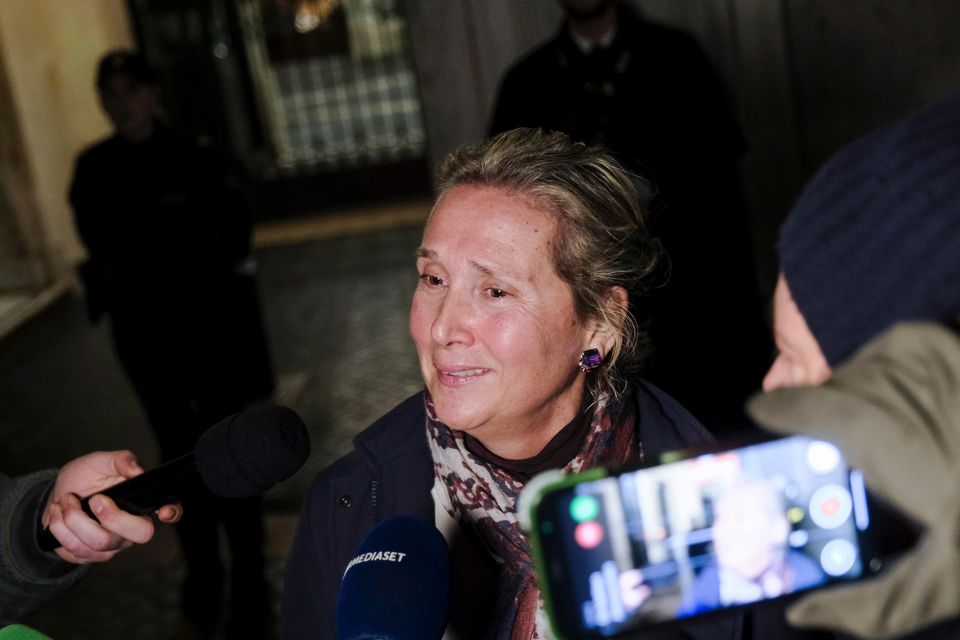An Italian journalist detained in Iran for three weeks has returned home after her fate became intertwined with that of an Iranian engineer arrested in Italy and wanted by the United States.
A plane carrying Cecilia Sala, 29, landed at Rome’s Ciampino airport, where Premier Giorgia Meloni was on hand to welcome her alongside family members.
Ms Sala’s companion Daniele Raineri posted a photo of a smiling Ms Sala greeting Ms Meloni in the airport.
In announcing that Ms Sala was flying home, Ms Meloni’s office said the premier had personally informed Ms Sala’s parents and credited the release to the government’s “intensive work on diplomatic and intelligence channels”.
Elisabetta Vernoni, pressed for her daughter’s release (Mauro Scrobogna/LaPresse via AP)
Iranian media acknowledged the journalist’s release, citing only the foreign reports.
The reporter for the Il Foglio daily was detained in Tehran on December 19, three days after she arrived on a journalist visa. She was accused of violating the laws of the Islamic Republic, the official IRNA news agency said.
Italian commentators had speculated that Iran detained and held Ms Sala as a bargaining chip to ensure the release in Italy of Mohammad Abedini, who was arrested by Italian authorities at Milan’s Malpensa airport three days before, on December 16, on a US warrant.
The US Justice Department has accused Mr Abedini and another Iranian of supplying the drone technology to Iran that was used in a January 2024 attack on a US outpost in Jordan that killed three American troops.
Mr Abedini remains in detention in Italy but has asked a Milan court to grant him house arrest pending an extradition hearing.
Ms Sala’s release was met with cheers in Italy, where her plight had dominated headlines, with lawmakers from across the political spectrum praising the outcome and the opposition Democratic leader Elly Schlein thanking the government specifically.
It came after Ms Meloni made a surprise trip to Florida last weekend to meet Donald Trump at his Mar-a-Lago estate.
Ms Meloni in a statement on X thanked “all those who helped make Cecilia’s return possible, allowing her to re-embrace her family and colleagues”.
Members of Ms Meloni’s cabinet took personal interest in the case given the geopolitical implications. Foreign minister Antonio Tanaji hailed the diplomatic teamwork involved to secure Ms Sala’s release.
But the release also posed a delicate political question for Italy given Mr Abedini’s status. The United States has complained in the past when Italy has lost track of suspects in the Italian judicial system awaiting hearings for extradition to the US.
A hearing on his bid to be given house arrest is scheduled for January 15.
Advocacy group Reporters Without Borders, which had flagged Ms Sala’s detention as an attack on press freedom, cheered her release.
We need your consent to load this Social Media content. We use a number of different Social Media outlets to manage extra content that can set cookies on your device and collect data about your activity.
“Now the 25 journalists still held in Iranian prisons must also be released,” the group said in a social media post.
Since the 1979 US Embassy crisis, which saw dozens of hostages released after 444 days in captivity, Iran has used prisoners with Western ties as bargaining chips in negotiations.
In September 2023, five Americans detained for years in Iran were freed in exchange for five Iranians in US custody and for 6 billion dollars in frozen Iranian assets to be released by South Korea.
Western journalists have been held in the past. Roxana Saberi, an American journalist, was detained by Iran in 2009 for around 100 days before being released.
Also detained by Iran was Washington Post journalist Jason Rezaian, who was held for more than 540 days before being released in 2016 in a prisoner swap between Iran and the US.
Both cases involved Iran making false espionage accusations in closed-door hearings.
